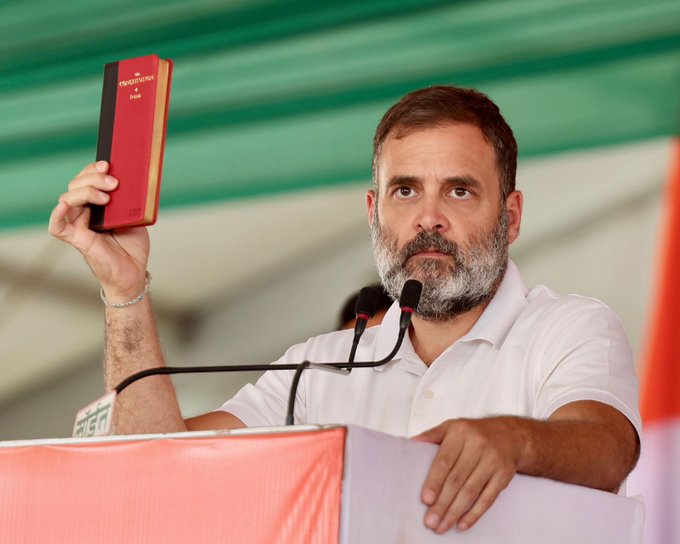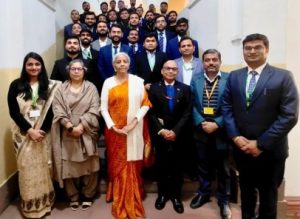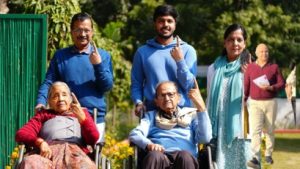Constitutional torchlight guides redistribution of wealth template

Image credit X @RahulGandhi
Examining redistribution of wealth against Constitutional provisions
By R. Narayanan
The controversy surrounding the inheritance tax — redistribution of wealth — has erupted after Sam Pitroda, former aide of Rajiv Gandhi and present associate of Rahul Gandhi, referred to the inheritance tax, prevailing in the US, during a discussion with the media. He mentioned that under the inheritance tax, if someone has $100 million, upon his death, his children will get only 45 per cent of the wealth and 55 per cent will be grabbed by the Government.
This means that half of the wealth earned in one’s lifetime upon death would go to the Government. If this innocuous statement had come from another Bharatiya Janata Party (BJP) intellectual, say Vinay Sahasrabuddhe (former Rajya Sabha MP), no one would have taken cognisance.
Since it has come from Rahul Gandhi’s aide, it has been a subject of hot discussion in the media. Prime Minister Narendra Modi seized the opportunity and said that the Congress party will loot the people not only when they are alive but also when they are dead.
Also read: Changing RSS, BJP relations in Lok Sabha elections
Rahul Gandhi, in a public meeting, in Hyderabad, said that the Congress Government, if voted to power, would carry out a financial and institutional survey to find out where the wealth of India lies and promised that his government would unleash revolutionary programmes to extend social justice to millions of countrymen.
These distribution of wealth/redistribution of wealth and so-called inheritance tax are nothing new to our country. The first government of India, headed by Jawaharlal Nehru, introduced estate duty, otherwise called inheritance tax, but it was abolished by Rajiv Gandhi government in 1985, not on merit, but because the revenue earned out of estate duty was far less than the expenditure involved on collections.
When the Governments are trying to mobilise more resources for its Governance, inheritance tax is an option. But, the cost of implementation was too high. There would be a threshold limit. Beyond that, only wealthiest people would have the kind of wealth to get inherited.
Most of them would try to avoid or would be happy to go for legal remedies. The cost for the Government, in either way, would be very high. No doubt, the inheritance tax does try to eliminate inequality. But it also creates rent seeking power with Government and potentially breeds corruption.
Also read: Akhilesh Yadav demands judicial probe in cases of Covishield side effects
Similarly, wealth tax was imposed by the Congress government headed by Nehru in 1957 but was abolished in 2015 by the NDA Government. In place of wealth tax, surcharge was introduced. In the same way, gift tax was introduced in 1958 but it was abolished in 1988.
The inheritance tax had been supported by various leaders – Jayant Sinha of the BJP when he was MoS (Finance), Arun Jaitley when he was Finance Minister in 2018, and also by P. Chidambaram, who was Home Minister in the UPA Government.
All of them supported because the inheritance tax was considered as a means to bring equity.
Most importantly, through first Constitutional Amendment Act 1951, the zamindari system (Permanent Settlement) was abolished. Is this not redistribution of wealth, under which two crore tenants of the lands were made owners of land which they tilled.
As a part of land reforms, land ceiling acts were introduced in 1961. These acts fixed the ceiling on the land holdings.
Also read: Columbia varsity calls in police to ‘free’ Hamilton Hall
The imposition of such ceiling was to deter the concentration of land in the hands of a few. These laws fixed the maximum holding beyond which no individual farmer or farm household can keep.
By 1961-62, all the State Governments had introduced the Land Ceiling Acts. The Ceiling limits differed from state to state.
In 1972 National Guidelines with ceiling limits were issued. It was 10 to 18 acres for best land and 18-27 acres for second class land and 27-54 acres for the rest.
Surplus possession of lands was taken over by the government for redistribution among the landless, including scheduled caste and scheduled tribe. This is also redistribution of wealth.
Under PM Kisan Samman Nidhi Yojana, every family is provided income support of ₹6000 per annum. The assistance is for all farmer families who have cultivable land, irrespective of the size of the land. This is also a kind of wealth distribution.
Also read: Dissecting poll percentage dip in charged Lok Sabha elections
Similarly, the GOI has nationalised banks, insurance companies, and transports. This is also a kind of redistribution of wealth.
Under Food Security Law, two-third of the population is covered to receive highly subsidised food grains.
Similarly, waiver of loans granted to farmers is also redistribution of wealth. Privy purses i.e. the pension being granted to the former kings were abolished in 1971, through 26th CAA (Constitution Amendment Act).
Tomorrow, after being voted to power, if the government of the day proposes to give unemployment allowance to each unemployed youth, it will also amount to redistribution of wealth.
No doubt, the market driven economy has resulted in additional resources for the government which has helped in bringing the people out of abject poverty.
However, it remains a fact that the economy system has resulted in growing inequality. A report of the World Inequality Lab has revealed that the top 10 per cent of our population have the share of 65 per cent of the wealth and 57 per cent of the income as of 2022-23.
Also read: Lok Sabha Poll: Congress gears up for leap of faith in Rae Bareli
In these circumstances, there is a need to examine the ground reality and deliberate on various programmes and policy to establish a welfare state.
Now the question is what is the extent of the mandate given in our Constitution to ensure economic justice. The preamble of the Constitution, which is the identity card and political horoscope, intends to establish India as a sovereign, socialist, secular, democratic republic and also to secure to all citizens socio, economic and political justice and equality of status and opportunities.
Economic justice means to ensure that the economic growth benefits all the people, by removing poverty and inequality. If the growth does not positively impact all sections of society, the government should take distributive justice programmes.
Almost all the schemes implemented by successive governments at the Centre fall under this because reduction of economic disparity is a preambular commitment.
In the directive principles of state policy (Part IV) Article 38, Article 39b, and Article 39c aim to set up a social order for promotion of welfare of the people. Of these, Article 38 emphasises a social order in which social economic and political justice shall inform all institutions of national life.
Also read: US-China lock horns to show blinking red eyes
This article also directs the government to strive for minimising the inequality of income, eliminate inequality in status, facility and opportunity not only among the individuals but also among the groups of people residing in different areas or engaged in different vocations.
Article 39(b) mandates that the ownership and control of material resources of a community are so distributed as to sub serve the common good. Article 39(c) says that the operation of the economic system should not result in concentration of wealth and means of production to the common detriment of the society.
The above three provisions are included in Part IV of the Constitution viz – Directive Principles of State Policy.
Article 37, at the outset, says that the Directive Principles cannot be enforced through court of law. So, technically there is no use of incorporating such provisions in the directive principles.
Nevertheless, Article 37 in the same breath says that though directive principles are not enforceable in the court of law, unlike fundamental rights in Part III, these directive principles are fundamental in the governance of the country and it should be duty of the State to apply these principles while making laws. The terms fundamental and duty have been used only in this part.
Also read: ‘Constitution is federal only in structure, not in spirit’
The term state referred to in Part IV includes Union Legislature, State Legislatures, Union Executive, State Executives, Local Authorities and other Authorities.
Most importantly, Indira Gandhi-led government through 25th CAA 1971 added Article 31C under which any law made to implement the directive principles in Article 39b and c cannot be questioned in any court of law, even if such a law is inconsistent with Article 14 (Equality clause), Article 19 (Seven-six now Freedoms) and Article 31 (Since deleted).
This amendment was upheld by Supreme Court in Keshavananda Bharati case of 1973. Thus, as of today Article 39 b&c have been kept at par with fundamental rights and if not more.
Another factor is that prior to 1978 there was an Article – Article 31 in Part III as Fundamental Right. However, for the first time in the Constitutional history of India Right to property, a fundamental right under Article 31 was deleted through 44th CAA 1978. No doubt Article 31 – Right to Property, after deletion from Part III had been kept as a Constitutional Right under Article 300A. The Supreme Court upheld the deletion of Fundamental Right to Property from Part III in Minerva Mill case of 1980.
Another important factor is first CAA 1951 added Article 31A and 31B along with Schedule IX. Under Article 31A, if a law is made to implement agrarian reforms like abolition of zamindari system, redistribution of land, etc., it cannot be struck down by the court on the ground of its inconsistency with Article 14, 19 and Article 31 (since deleted). Such a law can be made both by the Union and the States.
Also read: Punjab Speaks: ‘Cloud of despair hangs over Lok Sabha poll’
Article 31B speaks about the validation of certain acts and regulations. None of the Acts and regulations included in the 9th Schedule shall be deemed to be void on the ground of their inconsistency with Fundamental Rights.
Once a law is included in the 9th Schedule, it is fully protected against challenge in Court of law, for violation of Fundamental Rights. It can be a central law or State Laws. Such a law has to be placed in 9th Schedule, only after amending the Constitution.
In one amendment more than one law can be placed. This also acts retrospectively to confer validity on the laws which have been previously declared void by the court.
As a result, any legislation which was previously declared void by the Supreme Court on the ground that it violates any Fundamental Rights, receives protection, if such a voided law is included in the 9th Schedule of Article 31b.
In 1994, Tamil Nadu backward classes, Scheduled caste and Scheduled tribe reservation of seats in educational institutions and appointments or posts in services under the State Act of 1993 was included in the 9th Schedule, through 76th CAA 1994. The Tamil Nadu law had given 69 per cent reservation for BC, SC and ST.
Placing this act in 9th Schedule was done to protect this law from being invalidated by the Supreme Court as the law violated the 50 per cent ceiling for the caste-based reservations, stipulated by the Supreme Court in Indira Sawhny case of 1992 (Mandal case).
Also read: Stock market laps chip makers as scrips go soaring
Article 31B does not mention the type of cases which can be included in the 9th Schedule. This first Amendment Act was upheld by the SC in the Keshavananda Bharati case 1973.
In Raj Narayan Vs Indira Gandhi case of 1975, the SC declared that the judicial review is the basic structure of the Constitution. Accordingly, in Wamana case of 1981, the SC said that any addition to 9th Schedule, after Keshavananda Bharati case decision i.e. 23rd April 1973, would have to be examined w.r.t. their compatibility with the basic structure doctrine.
Therefore, distribution or redistribution of wealth is inherent in the Constitution and has been put in to affirmative action by successive governments through a number of Constitutional Amendments which have been largely upheld by the Supreme Court. Most importantly, Article 31A, Article 31B with Schedule IX which are the source of authority were added through 1st Amendment Act 1951 by GOI headed by Pandit Nehru (Leading member of Constitutional Assembly) in which Dr. B.R. Ambedkar – architect of the Constitution — was the law minister and Shyama Prasad Mukherjee was the industry minister.
Dr. Rajendra Prasad, who was the president of the Constitutional Assembly, was the President of India, who gave assent to the Bill.
(Opinion expressed in the article solely belongs to the author)







